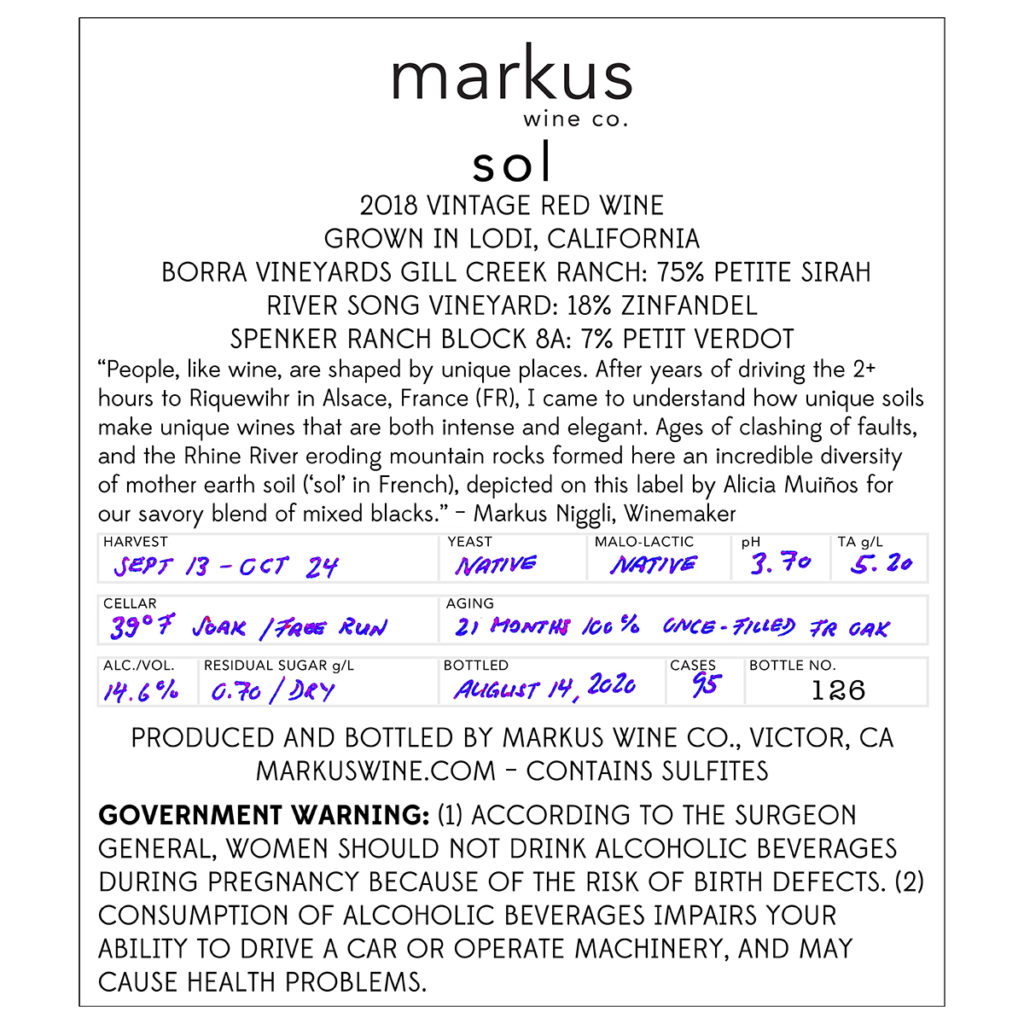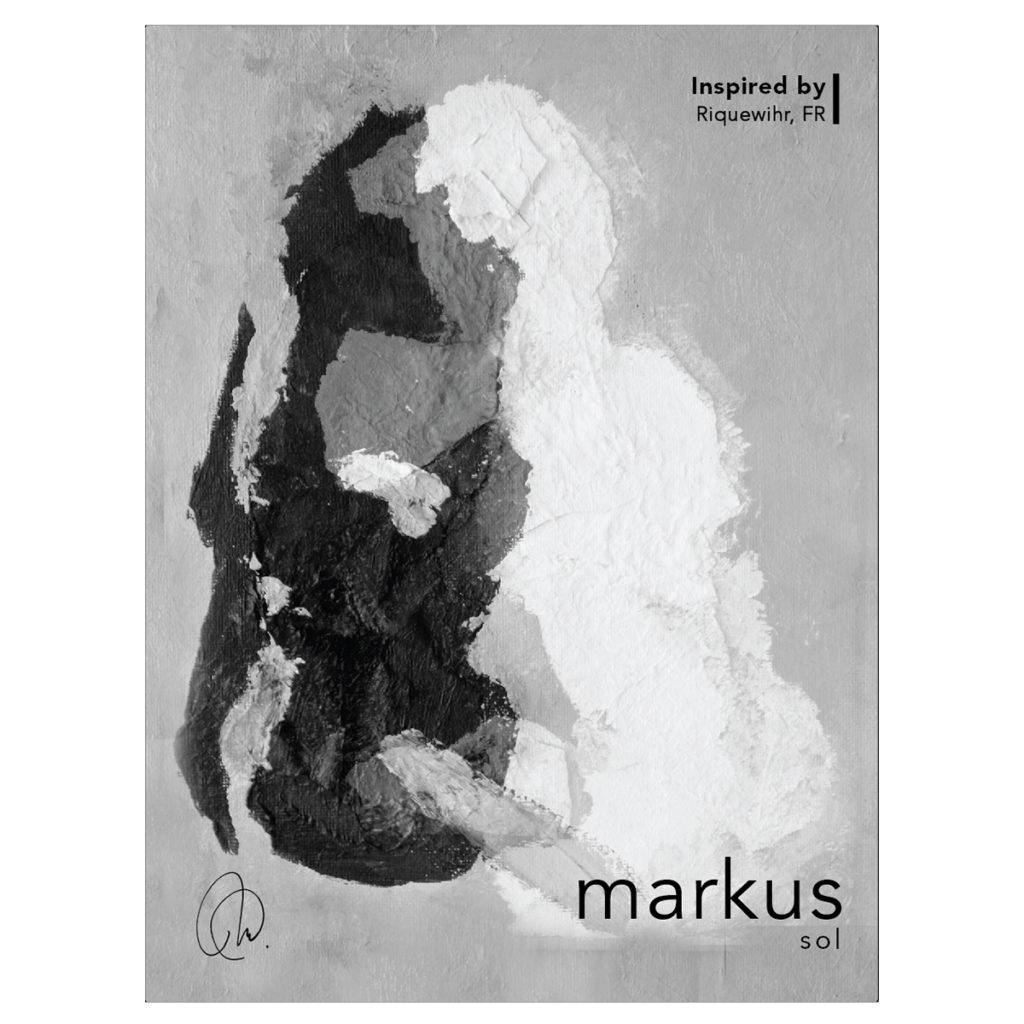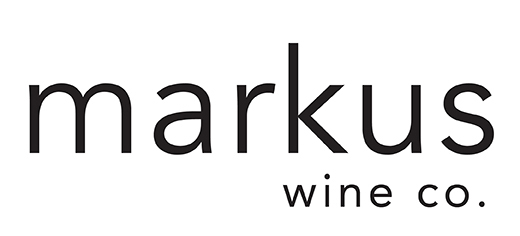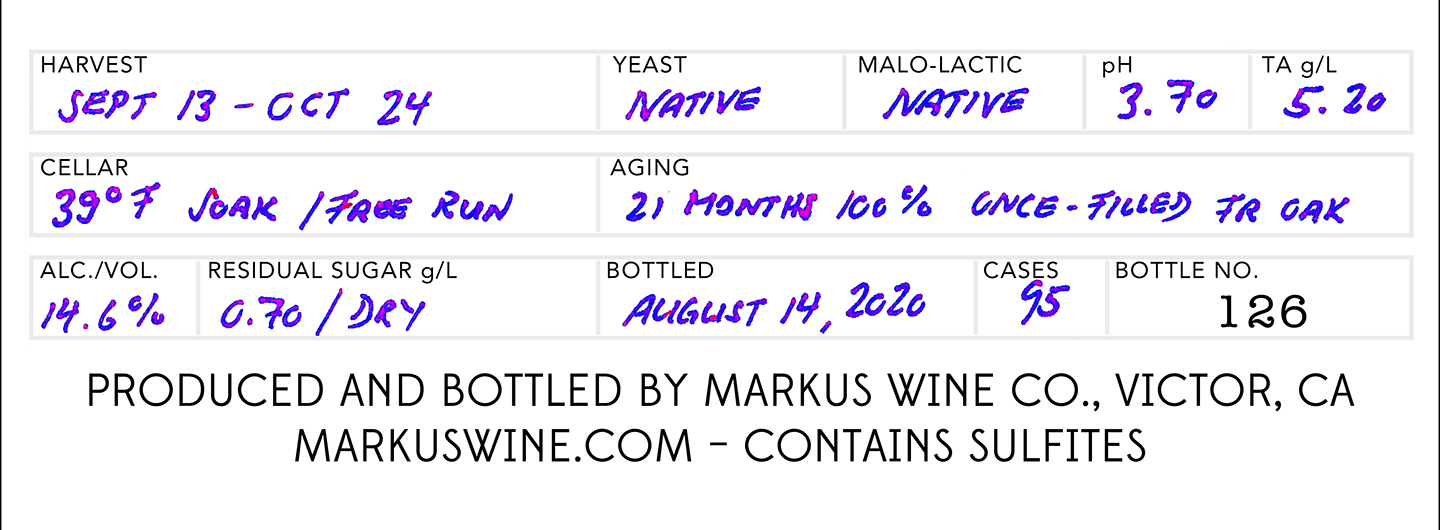We put maybe too much thought into what we print on our back labels. (We even make them 1/2″ wider than the fronts to fit everything in.) Here’s a breakdown of our thinking, using one of our red wine blends as an example…

Sources
What’s most important about our wines – all wines, really – is where they are grown, which is why we put that information right at the top:

Under our logo and the name of the wine – sol – we deliberately spell out for the Federal Government (TTB) the appellation in full. (TTB said the location printed on the front label was confusing. TTB kept rejecting our labels until we submitted artwork showing “GROWN IN LODI, CALIFORNIA.”)
Most of our wines are blends, and here you can find the complete breakdown of all the vineyard blocks with the varieties grown. Sometimes you do need to do the math to figure out the final blend by variety.
One reason why we list all the vineyards is to give proper credit to help build the reputation of the growers. Most of them deserve much better compensation for the fruit of all their labor. (But that’s another story.)
The Story
TTB officially calls the paragraph on the back label “marketing text” and sometimes “puffery.” They actually read each word very carefully to make sure we aren’t making false claims, or implying that drinking wine will make you powerful or healthy (though there are health benefits, of course).
We use this paragraph to tell the story of Markus’s wine life.

Each wine refers to a location or place that shaped or inspired Markus’s wine journey. You’ll find places like Weesen, Switzerland, where he was born, or Lodi, or, in this case, Riquewihr, France. If you line up all our bottles and turn them around, you basically get a quick biography.
Provided there’s room, we like to give credit to the artist who composed the front label on the bottle. Most of the artists were students at the University of the Pacific, under the direction of Professor Michael Leonard. For several years, Markus ran an annual contest for the art class. He gave a very brief description of what was influencing his ideas for a wine blend, then Michael would turn the class loose to brainstorm. Markus would return several weeks later and select the art that best captured his ideas.
Finishing up the paragraph is a very brief description of the wine. We didn’t have this description on earlier vintages of the labels. It wasn’t long before our main salesperson at the time – Mary Jo – told us that people wanted to have a better idea of what the wine tasted like, especially to know if the wine was dry or sweet. We went with the suggestion, using as few words as possible, so as not to implant our impressions too strongly over what our customers might discover themselves in the wine.
Specifications
Our focus on making different blends of unusual grape varieties means that we aren’t going to be very appealing to nice friends absolutely satisfied with everyday off-dry Chardonnay. (And, of course, there are perfect times for off-dry Chard.) The wine drinkers most interested in what we’re making are those that sometimes ask for the pH when we’re sharing wine with them.
We therefore decided to include the most commonly requested specs on the label:

Markus actually takes a piece of paper, lays it on a template, then hand writes all the information with a pen. (The ultimate winemaker’s signature perhaps?) Here’s what he puts in each section:
HARVEST
As you’d imagine, this is the date the grapes were picked. Since we often blend a number of grape lots, the range shows the first lot picked and the last lot picked. (We’re still not sure how useful this is. If you have a better idea, just let us know.)
YEAST & MALO-LACTIC
Most of our primary and secondary fermentations are completed with no purchased yeast or ML culture added. We use the common industry term “native,” whereas some may use “natural” or even “clean.” In the rare instance we do pitch yeast, we’ll print the name of the strain, since there are hundreds available. And for whites, we will often print “none” for Malo-Lactic when we deliberately try to prevent the secondary fermentation by chilling the wine in tank and/or adding SO2.
We add SO2 to all of our wines if needed during aging, and always shortly before bottling to keep the wines stable against oxidation and any possible organisms. Our higher-than-usual acidity tends to allow us to keep the SO2 at minimal levels.
pH & TA
As mentioned, since we pick on the earlier side of the harvest window, our wines tend to carry more acid structure than much of what you’ll find on the market. We’ve had some vintages of whites under pH 3.1. (The 2013 Nimmo was 2.70!) Only one wine was over pH 3.8 – the 2017 Toura at 3.87. No TA (total acidity) has been under 5 g/L, and only the Nativo and Nimmo have been at or over 7 g/L. Our recent vintages of whites tend to be 6-7 g/L and reds 5-6 g/L.
CELLAR & AGING
We’ll include the most interesting aspects of our fermentation and cellar work, such as: cold soak prior to fermentation; length in days for a long cold fermentation; free run drain without applying pressure in the press; months in stainless steel tanks or months in the specified used oak barrels.
ALC./VOL.
The actual alcohol by volume lab result comes back showing hundredths, but we round to the nearest tenth, i.e., 14.63% is written on the label as 14.6%. We run the labs one or two months before bottling to insure accuracy for the label. Even though TTB allows a fairly wide tolerance, we prefer to show what is actually in the bottle. If there is a rare deviance because of last-minute cellar work, we’ll show the revised alcohol on our website.
RESIDUAL SUGAR g/L
Here is where we show the sugar level from our lab results, obtained one or two months before we bottle. Also shown is our own perception of the dryness of the wine. It is possible to see “dry” along with a normally-sweet RS of over 2 g/L because there is balancing strong acidity, particularly with our whites with pHs around 3.1. We have also made wines we show as “off-dry” or “sweet” (such as our Crealto). The RS is a good guide, but the wine must really be tasted to get the overall impression of the dryness.
BOTTLED, CASES & BOTTLE NO.
Here we show the bottling information. The cases are the total of 12-pack cases that we bottle of the entire lot of that wine. We only label a portion of that lot as “Markus Wine Co.” The rest is made available as unlabeled bottles (“shiners”) sold to other wineries that may choose to mention Markus or not. The bottle number shows the order in which the bottle exited the bottling truck. The largest bottle number will likely be less than 12 times the number of cases, due to the shiners, if you happen to have whipped-out your calculator.
Bottler’s Address
TTB officially refers to the “Produced and Bottled by” statement as the “bottler’s address.”

We received our TTB winery permit to operate in Victor, California on August 20, 2018, just as crush was gaining momentum. Therefore, all wine we fermented starting with the 2018 vintage shows as “PRODUCED.” Wine we fermented at our former parent company, Borra Vineyards, shows as “CELLARED.” Sometimes we choose to bottle at another winery. In that situation, we give them permission to use our name to bottle wine we fermented, and you will see “CELLARED.”
That about covers it, but since you’ve been staring at the back label for so long, here’s the front label for Sol, including the name of the place that was an inspiration to Markus:

Hopefully this explanation has been useful. If you have any questions, feel free to let us know.
Cheers!
– Markus Team Member Jon
P.S. We received a very nice mention of our back labels by Wine Enthusiast’s Jim Gordon in his article “To Attract More Drinkers, Wine Needs Clearer Labels.“
He writes, in part, “A few U.S. wineries like Ridge Vineyards, Bonny Doon Vineyard, Dry Creek Vineyard and Markus Wine Co. have adopted label transparency measures, too. For many years, Ridge has declared everything that goes into their wines, including items like ‘hand-harvested, sustainably grown, organic grapes;’ ‘indigenous yeasts;’ ‘naturally occurring malolactic bacteria;’ ‘oak from barrel aging;’ ‘calcium carbonate’ and ‘minimum effective SO2.'”

